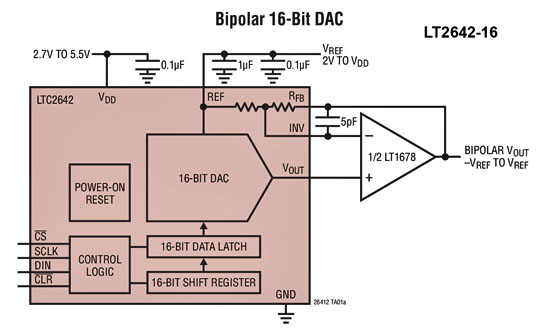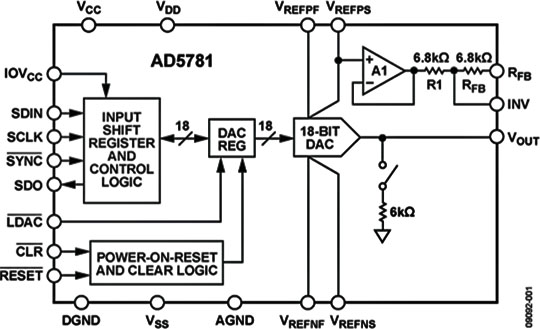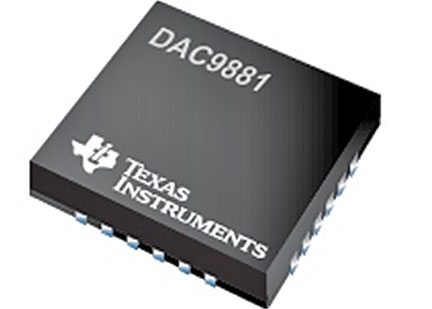By: Jim Harrison
D/A converters have a lot of application areas — especially very high-speed (5 Gs/s) D/As, which are key elements in radar, medical diagnostic equipment, TV sets, cellular base stations, and security scanners. Specialized 24-bit audio D/As inhabit headphones and speaker outputs everywhere.
What about when you don’t care at all about speed and what your design requires is high accuracy and a really low price — and low power is always nice as well? First off, high accuracy, at the moment, means 16 bits or 18 bits — and there’s quite a price jump between the two. You can also get some really cheap 16-bit D/As — as low as $2 each — but they are not real, as their non-linearity is so poor that they are really 12-bit devices.
Four companies are the main players in accurate, not very speedy, D/A converters: Maxim Integrated, Texas Instruments, Analog Devices, and Linear Technology. Let’s look at a few good examples. I chose only voltage-output, single-channel devices for this article.
Example devices
Linear Technology offers the LTC2641 16-bit VOUT DAC in a 3 × 3-mm DFN package. The IC comes in many versions (including 12- and 14-bit versions). The one we want to reference is the LTC2641CDD-16#PBF, which costs $6.25 ea/1,000. It provides ±1 LSB INL maximum and ±1 LSB DNL maximum over-temperature.

The device's unbuffered output requires an external amplifier, but it features a really low active supply current of 120 µA and a low offset error of ±1 LSB. An external reference is also needed. The converter uses a SPI/MICROWIRE-compatible three-wire serial input, which can be operated at clock rates up to 50 MHz. It uses a single 2.7- to 5.5-V supply and comes in commercial or industrial temperature ranges with four package types.
Analog Devices offers the 18-bit AD5781 that is specified over −40°C to 125°C and has two flavors. The B version has an outstanding ±0.5 LSB INL and the A version has a less admirable ±4 LSB INL. The B version is $37.45 ea/100, and the A is $25.83 ea/100. This device uses a three-wire serial interface that operates at clock rates of up to 35 MHz. DNL is ±0.25 typical, ±0.5 LSB maximum.

For the B version, zero-scale error is ±0.025 LSB typical and ±1.75 LSB maximum when using a 10-V supply, but rises to ±0.19 typical, ±5.25 LSB maximum when using a 5-V supply. The chip uses three supplies: VDD (~7.5 V), VSS (−16.5 V to −2.5 V), and VCC (digital supply; 2.7 to 5.5 V). The VDD current is 5.2 mA max and the VSS 4.9 mA max.
The Analog Devices’ AD5761 is a 16-bit D/A with an internal reference and eight software-programmable output ranges. Reference drift is a good ±2 ppm/°C typical and total unadjusted error (TUE) is 0.1% FSR maximum. The device offers guaranteed monotonicity, integral nonlinearity of ±2 LSB maximum, 35-nV/√Hz noise, and 7.5-μs settling time on selected ranges. There are a number of versions of this part, all of which are specified over −40°C to 125°C. The B version (AD5761RBxx) costs $8.07 ea/100.
Texas Instruments is a leader in most analog ICs, and D/As are no exception. The DAC9881SB is an 18-bit D/A with integral non-linearity of ±2 LSB maximum. DNL is ±0.5 LSB typical, ±1 LSB maximum and zero-scale error is ±32 LSB max over its −40°C to 105°C operating range. Gain temperature drift is ±0.4 ppm/°C maximum. It uses a single 2.7- to 5.5-V supply and takes less than 1.5 mA. The IC needs an external reference and comes in a 4 × 4-mm QFN24 package with a price tag of $35.64 ea/100.

For a 16-bit D/A, TI offers 35 different models. The stalwart DAC8830 has been around for about 10 years and is still a good deal. The DAC8830 and DAC8831 (bipolar output) single-channel D/As operate from one 3- to 5-V supply. The “linearity error” for the devices depends on their version. The typical is always ±0.5 LSB, but the maximum over-temperature (40°C to 85°C) can be 4 LSB. The DAC8830ICD version has a ±1 LSB maximum specification and costs $11.36 ea/100.
These converters take only 15 µW at 3 V and offer very low noise (10 nV/√Hz) and fast settling (1.0 μS to 1/2 LSB of full-scale output) over the specified temperature range of −40°C to 85°C. The output is unbuffered, so you will need to add an amp. The DAC8830 comes in an SO-8 package, and the DAC8831 in an SO-14.
Maxim Integrated has the MAX5216 16-bit D/A converter that uses an external reference applied through the high-resistance input and has rail-to-rail operation and low system power consumption. The IC offers an INL of ±1.2 bits typical and ±4 bits maximum. Differential non-linearity is ±0.25 typical and ±1 bit maximum. This device is just $3.09 ea/1,000. The chip uses a 2.7- to 5.5-V power supply taking only 80 µa current max — and 2 µa max in standby. It uses a three-wire SPI-/QSPI-compatible serial interface. Simple serial interfaces save board space and reduce complexity when isolation is needed. It features a low offset error of ±0.25 mV and a small 3 x 5-mm, 8-pin package along with specifications covering the −40°C to 105°C extended industrial temperature range.
Another Maxim device, the MAX5318, is an 18-bit serial output device INL of ±2 LSB maximum and ±0.5 typical. DNL is ±1 LSB maximum. At $21.30 ea/50, it’s not overly expensive. However, the “Zero Code Error” is ±48 LSB maximum, ±4 typical, so I guess an offset adjustment mechanism may be in order. This specification is over the full −40°C to 105°C operating range and the temperature drift is around 1 ppm/°C. Also, gain error is ±16 LSB maximum, ±1 typical. It uses an external 2.4-V reference and takes 6.5 mA from a 3.0-V supply. It’s packaged in a 4.4 x 7.8-mm, 24-lead TSSOP.
Advertisement
Learn more about Analog DevicesLinear TechnologyMaxim IntegratedTexas Instruments





